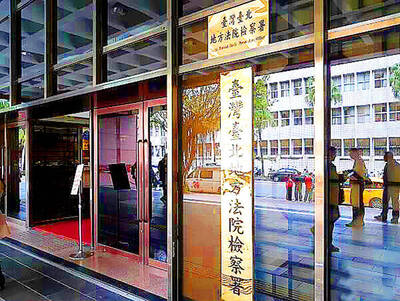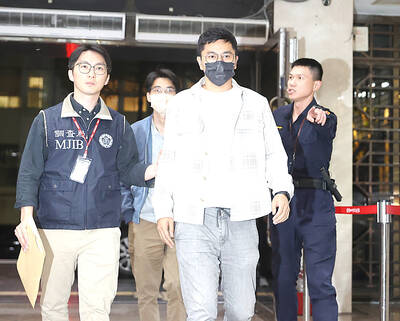Several leaked cables from the American Institute in Taiwan (AIT) show that the US made “considerable effort” in negotiations leading to a secret memorandum of understanding (MOU) signed between China and the WHO in 2005, in which Taiwan was referred to as “Taiwan, China,” and repeatedly urged Taiwan not to make the text public.
Among thousands of cables from the AIT published by WikiLeaks on Aug. 30, at least four cables show a US role in crafting the 2005 agreement.
It supported the use of the term “Taiwan, China” and it wished this to be kept confidential.
The information in the cables shows contradictions with the US policy of taking no position on Taiwan’s sovereignty and contradicts the view held by the Democratic Progressive Party (DPP) that the MOU came after closed-door talks between the Chinese Nationalist (KMT) and Chinese officials.
A cable dated May 13, 2005, shows the MOU was an integral part “of the four-part package that had been worked out after considerable effort by US negotiators” to enable Taiwan to participate in the global International Health Regulations (IHR) framework for infectious disease control.
On May 23, 2005, the WHO revised and expanded the IHR, implemented since 1969, to cover any significant public health risks and events, which constitutes public health emergencies of international concern as well as plague, which remains one of the diseases of concern at its annual World Health Assembly (WHA).
According to the cables, the then-DPP administration was aware of what was being discussed in the negotiations and raised objections to their possible content, but did not obtain a copy of the text.
The cable showed that Taiwan “cannot accept the use of the term ‘Taiwan, China’ in the MOU that the PRC [People’s Republic of China] plans to sign with the WHO Secretariat. It also insists that it is unreasonable for the WHO to notify the PRC representative office in Geneva before engaging in cooperation with Taiwan under the IHR,” as stated in a press release sent out on May 12 following a Chinese diplomatic note “that has been circulated and apparently made public in Geneva.”
In response to Victor Chin (秦日新), then the director-general of the Department of North American Affairs at the Ministry of Foreign Affairs, then-AIT deputy director David Keegan, who is not named in the cable, said that US negotiators worked on the negotiations “in full consultation with [their] Taiwan counterparts.”
A cable dated March 2, 2005, recording a meeting between then-AIT director Douglas Paal and John Chen (陳忠), then director-general of the ministry’s Department of International Organizations, quoted Paal as saying that the “US was grateful” that Taiwan and its diplomatic allies had not again raised the proposal to amend Article 65 of the IHR.
“The PRC had indicated that it would withdraw its concessions if there were further mention of Article 65,” Paal is quoted by the cable as saying.
A cable dated Oct 24, 2004, shows that Taiwan tried, with the help of Nicaragua, to add language to Article 65 of the draft IHR to extend coverage of the IHR to any “territory exercising competence over its external health relations” and requested US assistance in getting it accepted.
The talking points presented to the AIT by then-director of the Centers for Disease Control (CDC) Steve Kuo (郭旭崧) read that Taiwan “proposed that an amendment be made to Article 65 to include, in addition to non-member states, any entity with a separate health administration as well,” the cable showed.
Paal said China concurred “there would be direct discussions between WTO and ‘Taipei CDC’ on a proposed exchange of letters ... on the condition that there was no publicity” and that “WHO teams could go to Taiwan in the event of another public health emergency of international concern ... subject only to WHO notification of the Chinese mission in Geneva,” according to a cable from March 2, 2005.
“Chen, however, requested further US help to modify the term of the PRC-WHO agreement, in response to which the Director [Paal] was not encouraging,” the cable shows.
Chen said Taiwan hoped the WHO-PRC agreement would not contain language detrimental to Taiwan.
Meanwhile, a cable dated May 16, 2005, shows that the US wanted Taiwan to accept the nomenclature and urged it not to make the text of the MOU public.
Keegan, who is again not named in the cable, talked to then-National Security Council secretary-general Chiou I-ren (邱義仁) and Chin over the matter on May 14, urging that “Taiwan not allow its sensitivity over nomenclature to prevent this step forward in its WHO access and this improvement in its international stature.”
In response to the US’ concerns, then-vice minister of foreign affairs Michael Kau (高英茂) called the AIT deputy director and told him that “Taiwan’s Geneva delegation had not/not obtained a copy of the WHO-PRC MOU and that it intended to respect the confidentiality of the MOU and its language,” the cable reads.
“He [Kau] stressed however that ‘we hate’ the use of ‘Taiwan, China,’” the cable says.
Keegan told Chin on May 12, 2005, that “the MOU language would not be a public document, and that it would be hardly surprising if a UN organization and a UN member used UN terminology to refer to Taiwan, however much Taiwan might disagree with that terminology,” as recorded in the cable dated May 13, 2005.

INVESTIGATION: The case is the latest instance of a DPP figure being implicated in an espionage network accused of allegedly leaking information to Chinese intelligence Democratic Progressive Party (DPP) member Ho Jen-chieh (何仁傑) was detained and held incommunicado yesterday on suspicion of spying for China during his tenure as assistant to then-minister of foreign affairs Joseph Wu (吳釗燮). The Taipei District Prosecutors’ Office said Ho was implicated during its investigation into alleged spying activities by former Presidential Office consultant Wu Shang-yu (吳尚雨). Prosecutors said there is reason to believe Ho breached the National Security Act (國家安全法) by leaking classified Ministry of Foreign Affairs information to Chinese intelligence. Following interrogation, prosecutors petitioned the Taipei District Court to detain Ho, citing concerns over potential collusion or tampering of evidence. The

TRADE: The premier pledged safeguards on ‘Made in Taiwan’ labeling, anti-dumping measures and stricter export controls to strengthen its position in trade talks Products labeled “made in Taiwan” must be genuinely made in Taiwan, Premier Cho Jung-tai (卓榮泰) said yesterday, vowing to enforce strict safeguards against “origin laundering” and initiate anti-dumping investigations to prevent China dumping its products in Taiwan. Cho made the remarks in a discussion session with representatives from industries in Kaohsiung. In response to the US government’s recent announcement of “reciprocal” tariffs on its trading partners, President William Lai (賴清德) and Cho last week began a series of consultations with industry leaders nationwide to gather feedback and address concerns. Taiwanese and US officials held a videoconference on Friday evening to discuss the

NEGOTIATIONS: The US response to the countermeasures and plans Taiwan presented has been positive, including boosting procurement and investment, the president said Taiwan is included in the first group for trade negotiations with the US, President William Lai (賴清德) said yesterday, as he seeks to shield Taiwanese exporters from a 32 percent tariff. In Washington, US Trade Representative Jamieson Greer said in an interview on Fox News on Thursday that he would speak to his Taiwanese and Israeli counterparts yesterday about tariffs after holding a long discussion with the Vietnamese earlier. US President Donald Trump on Wednesday postponed punishing levies on multiple trade partners, including Taiwan, for three months after trillions of US dollars were wiped off global markets. He has maintained a 10 percent

PERSONAL DATA: The implicated KMT members allegedly compiled their petitions by copying names from party lists without the consent of the people concerned Judicial authorities searched six locations yesterday and questioned six people, including one elderly Chinese Nationalist Party (KMT) member and five KMT Youth League associates, about alleged signature forgery and fraud relating to their recall efforts against two Democratic Progressive Party (DPP) legislators. After launching a probe into alleged signature forgery and related fraud in the KMT’s recall effort, prosecutors received a number of complaints, including about one petition that had 1,748 signatures of voters whose family members said they had already passed away, and also voters who said they did not approve the use of their name, Taipei Deputy Chief Prosecutor